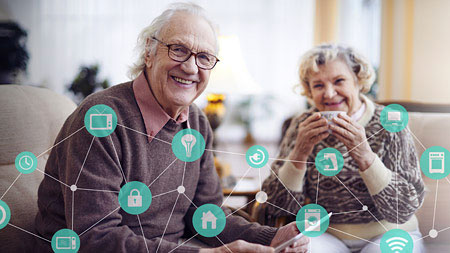Worried about your elderly parent living alone at home?

New technologies can help the elderly to continue leading independent lives. Sensor-based systems using complex analytical methods are able to detect emergencies and call for help when necessary.
Populations in many industrialized nations are getting older. This entails wide-ranging changes and problems in many different areas. Ambient Assisted Living (AAL for short) can play a key role in meeting the challenges posed by this demographic shift. AAL is an umbrella term for intelligent technologies that are integrated discreetly into people’s lives, helping them cope with their everyday routines in a wide variety of ways. A major benefit of AAL is that it can allow older people to continue leading independent lives for as long as possible in their own familiar surroundings. This can greatly enhance quality of life, and maintain it at a high level well into old age.
Wide-ranging solutions for Ambient Assisted Living
Configuring a home to be suitable for an elderly person starts with relatively simple solutions, such as remote control window blind and shutters, or motion sensors to control the lights. Other solutions include communications and emergency call systems, mobility aids, household safety systems such as automatic cooker switch-off or fire alarms, as well as technical aids to help with strenuous physical activities. Smart Home solutions can also help the elderly, by automatically switching off the heating as soon as a window is opened, for example. A more complicated challenge is to detect emergencies and automatically call for help.
Critical situations are automatically detected
As one example, the “easierlife” system from the company of the same name uses contact sensors on the doors and motion sensors distributed around the home. The sensors are connected wirelessly to a base station which communicates with an app on the user’s smartphone over the mobile phone network. Intelligent analytical methods are employed to process data providing information about the resident’s behaviors in the home. This enables the system to detect critical situations automatically: the resident fails to get up at the normal time in a morning, does not return from a walk for a long time, or has been in the bathroom for hours. In such a case, a notification message is automatically sent toh the smartphone of a person who can help.
Identifying changes in health status
However, it involves the resident wearing an armband which not only monitors actions such as sitting, walking or standing, but also the person’s location in the home. The armband works together with so-called beacons. These are small transmitters mounted on the walls which act as location trackers. The data collected from them is analyzed in a Cloud application. In this way, the system learns the resident’s everyday routines, detects changing behavior patterns, and is able to identify when they are important. This means, for example, that the resident might simply just be sleeping if he or she has been lying down for two hours in the living room. But if he or she has been lying in the bathroom for two hours, the system would notify the designated helper of a potential emergency. The solution not only provides assistance in the event of an acute emergency such as a fall, but also utilizes any minor discrepancies in daily routines to deduce possible changes in the person’s health status. This might, for example, relate to how frequently an elderly person eats, or how often he or she takes a nap. Such systems not only assure rapid response in emergencies, but also provide users with a greater sense of safety and security – a key prerequisite in being able to keep enjoying a familiar and often much-loved home in later life.
According to a recent World Bank report, East Asia is aging faster and on a larger scale than any other region in history. More than 211 million people aged 65 and above live in East Asia – including 130 million of them in China alone. Faced with this rapidly aging population, governments are racing to improve the healthcare system to face this impending crisis.
This also throws an opportunity for companies in private and public sectors to develop and deploy products, systems and services targeting the elderly at home. New technologies such as the ones described above makes it possible to remotely monitor elderly at home or outside and also to control the environment they live in.

